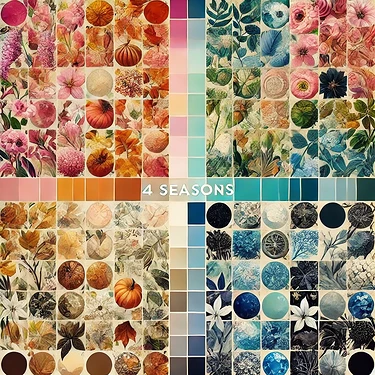The 4 Seasons Color Analysis System is one of the foundational methods used in personal color analysis. It organizes people into one of four seasonal groups—Spring, Summer, Autumn, or Winter—based on two primary factors: undertone and depth. This system has helped people around the world find colors that enhance their appearance by harmonizing with their skin tone, hair, and eyes.
The Origins of the 4-Season System
The 4-Season system became widely popular in the 1980s with Carole Jackson’s book Color Me Beautiful. However, the idea of linking people’s natural coloring with the four seasons dates back to Johannes Itten in the 1920s and Suzanne Caygill in the 1940s and 1950s. Jackson refined these ideas into a system that’s accessible to the general public, making it easy for people to discover their best colors by understanding their seasonal category.
How the 4-Season System Works
The 4-Season Color Analysis System is based on two key factors:
- Undertone: This is the primary dimension of the system and refers to whether your skin’s natural hue is warm (yellow, peach, or golden) or cool (pink, blue, or red).
- Warm undertones: Spring and Autumn
- Cool undertones: Summer and Winter
- Depth: This is the secondary dimension that helps to organize the seasons based on whether your overall coloring is light or dark.
- Light: Spring and Summer
- Dark: Autumn and Winter
These two factors—undertone and depth—combine to create the four distinct seasonal palettes. Each season contains colors that best complement your natural combination of undertone and depth.
The 4 Seasons Explained
Here’s a breakdown of the four seasons and the types of colors that suit each:
Spring (Warm Undertone, Light Depth)
People with Spring coloring have a warm undertone and light overall coloring. Their features are often fresh, clear, and light. Spring colors are warm, bright, and fresh, including shades like coral, peach, light gold, warm turquoise, and soft greens. These colors enhance the warmth and lightness of Spring features.
Summer (Cool Undertone, Light Depth)
Summer types have cool undertones with light coloring. Their features tend to be soft and delicate, often with lighter hair and cool, light eyes. Summer colors are cool, soft, and muted, including pastels like lavender, soft pinks, powder blue, and dusty rose. These cool and gentle hues flatter the soft, cool nature of Summer’s features.
Autumn (Warm Undertone, Dark Depth)
People with Autumn coloring have a warm undertone with deeper, richer overall coloring. Their features are warm and earthy, often with darker hair and warm, rich eyes. The Autumn palette is made up of earthy, rich colors like mustard, rust, olive, and burnt orange. These shades bring out the depth and warmth of Autumn features.
Winter (Cool Undertone, Dark Depth)
Winter types have cool undertones and dark, high-contrast features. Their features are bold, often with dark hair, striking eyes, and cool-toned skin. The Winter palette is filled with high-contrast, cool colors like black, navy, true white, and jewel tones such as emerald and royal blue. These vivid, cool colors emphasize the striking contrast typical of Winter’s features.
Understanding the 12 Seasons System for Greater Flexibility
The 4-Season System is an excellent foundation for discovering your best colors. However, it may not fully capture the nuances of everyone’s unique coloring. The 12 Seasons Color Analysis System builds upon the 4-season approach by introducing an additional dimension—intensity. This allows for more flexibility and precision, offering a wider range of color categories that take into account brightness or softness, alongside undertone and depth.
By expanding the four seasons into twelve, this system offers a more personalized and accurate way of finding colors that harmonize with your individual features.
How Colorwise Uses the 4 Seasons
At Colorwise.me, we default to the 12 Seasons Color Analysis System because it offers more precise color matching by including depth and intensity. However, if your natural coloring doesn’t neatly fit into one of the 12 subcategories, our algorithms will automatically switch to the classical 4-season system. This flexibility ensures that you’re always guided toward the colors that suit you best.
Got questions about your color season? Leave them in the comments, or try the tools on Colorwise.me to explore your color season today!

